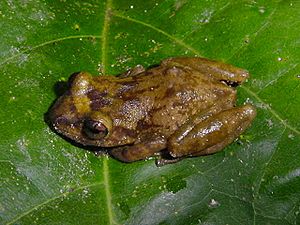Eleutherodactylus ionthus facts for kids
Quick facts for kids Eleutherodactylus ionthus |
|
|---|---|
 |
|
| Conservation status | |
| Scientific classification | |
| Synonyms | |
|
Eleutherodactylus varians ssp. ionthus Schwartz, 1960 |
The Eleutherodactylus ionthus is a special type of frog that lives only in Cuba. This small frog belongs to a group called Eleutherodactylidae, often known as "rain frogs" or "slipper frogs." It makes its home in warm, wet forests, both in low areas and up in the mountains. Sadly, this unique frog is in danger because its home is disappearing.
Contents
Meet the Cuban Rain Frog!
The Eleutherodactylus ionthus is a fascinating frog species. It was first described by a scientist named Albert Schwartz in 1960. This frog is part of a large family of frogs called Eleutherodactylidae. These frogs are special because many of them do not need water to lay their eggs. Instead, their eggs hatch directly into tiny froglets, skipping the tadpole stage!
Where Does It Live?
This frog is endemic to Cuba. This means you can only find it living naturally in Cuba and nowhere else in the world. It prefers very specific places to live:
- Warm, Wet Lowland Forests: These are forests close to sea level that get a lot of rain and stay warm all year.
- Moist Mountain Forests: It also lives in forests found on the sides of mountains, where it's still very wet and tropical.
These habitats provide the perfect damp and sheltered conditions for the Eleutherodactylus ionthus to thrive.
Why Is It Important?
Every animal plays a role in its ecosystem. Frogs like the Eleutherodactylus ionthus are important because they eat insects, which helps control insect populations. They also serve as food for other animals, like birds and snakes. When a species is endemic, like this frog, it means it's extra special and unique to its home country. Losing it would mean losing a part of Cuba's natural heritage forever.
What Threats Does It Face?
The biggest problem for the Eleutherodactylus ionthus is habitat loss. This happens when the places where the frogs live are destroyed or changed.
- Deforestation: Forests are cut down for farming, building, or other human activities. This takes away the trees and plants the frogs need for shelter and hunting.
- Human Development: As towns and cities grow, they can spread into natural areas, breaking up the frog's habitat.
- Climate Change: Changes in temperature and rainfall patterns can also affect the moist conditions these frogs need to survive.
Because of these threats, the Eleutherodactylus ionthus is listed as an endangered species. This means it is at a high risk of becoming extinct in the wild.
How Can We Help?
Protecting the Eleutherodactylus ionthus means protecting its home.
- Conservation Efforts: Scientists and conservation groups work to protect the forests where these frogs live.
- Protected Areas: Creating national parks and reserves helps keep natural habitats safe from development.
- Awareness: Learning about these amazing creatures and sharing what you know can help others understand why they are important to protect.
See also
 In Spanish: Eleutherodactylus ionthus para niños
In Spanish: Eleutherodactylus ionthus para niños


